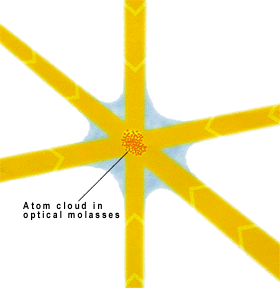Optical molasses

Optical molasses is a laser cooling technique that can cool neutral atoms to as low as a few microkelvin, depending on the atomic species. An optical molasses consists of 3 pairs of counter-propagating orthogonally polarized laser beams intersecting in the region where the atoms are present. The main difference between an optical molasses (OM) and a magneto-optical trap (MOT) is the absence of magnetic field in the former. Unlike a MOT, an OM provides only cooling and no trapping.
History
[edit]When laser cooling was proposed in 1975, a theoretical limit on the lowest possible temperature was predicted.[1] Known as the Doppler limit, , this was given by the lowest possible temperature attainable considering the cooling of two-level atoms by Doppler cooling and the heating of atoms due to momentum diffusion from the scattering of laser photons. Here, , is the natural line-width of the atomic transition, , is the reduced Planck constant and, , is the Boltzmann constant.
The first experimental realization of optical molasses was achieved in 1985 by Chu et al. at AT&T Bell Laboratories. [2] The authors measured laser cooling of neutral sodium atoms down to the theoretical Doppler cooling limit by observing the fluorescence of a hot atomic beam.
Experiments at the National Institute of Standards and Technology, Gaithersburg, found the temperature of cooled atoms to be well below the theoretical limit.[3] In 1988, Lett et al.[3] directed Sodium atoms through an optical molasses and found the temperatures to be as low as ~40μk; 6 times lower than the expected 240μk doppler cooling limit. Other unexpected properties found in other experiments[4] included significant unexpected insensitivity to laser alignment of the counter-propagating beams.
These unexpected observations led to the development of more sophisticated models[5] of laser cooling that took into account the Zeeman and hyperfine sublevels of the atomic structure. The dynamics of optical pumping between these sublevels allow for the cooling of atoms below the Doppler limit.
Theory
[edit]The best explanation of the phenomenon of optical molasses is based on the principle of polarization gradient cooling.[6] Counterpropagating beams of circularly polarized light cause a standing wave, where the light polarization is linear but the direction rotates along the direction of the beams at a very fast rate. Atoms moving in the spatially varying linear polarization have a higher probability density of being in a state that is more susceptible to absorption of light from the beam coming head-on, rather than the beam from behind. This results in a velocity dependent damping force:[7]
where The variable is the reduced Planck constant, is the saturation intensity, is the laser detuning, and is the linewidth of the atom cooling transition. For sodium, the cooling (cycling) transition is the transition, driven by laser light at 589 nm.
The optical molasses can reduce the atom temperature to the recoil limit, , is set by the energy of the photon emitted in the decay from the J’ to J state, where the J state is the ground state angular momentum and the J’ state is the excited state angular momentum. This temperature is given by though practically the limit is a few times this value because of the extreme sensitivity to external magnetic fields in this cooling scheme. Atoms typically reach temperatures on the order of , as compared to the doppler limit .
Relation to magneto-optical trap
[edit]An optical molasses slows down the atoms but does not provide any trapping force to confine them spatially. A magneto optical trap employs a 3 dimensional optical molasses along with a spatially varying magnetic field to slow down and confine the atoms.
See also
[edit]- Doppler cooling
- Gray molasses
- Magneto-optical trap
- Laser cooling
- Polarization gradient cooling
- Sub-Doppler cooling
References
[edit]- ^ Hänsch, T.W.; Schawlow, A.L. (1975). "Cooling of gases by laser radiation". Optics Communications. 13 (1): 68–69. Bibcode:1975OptCo..13...68H. doi:10.1016/0030-4018(75)90159-5. ISSN 0030-4018.
- ^ Chu, Steven; Hollberg, L.; Bjorkholm, J. E.; Cable, Alex; Ashkin, A. (1 July 1985). "Three-dimensional viscous confinement and cooling of atoms by resonance radiation pressure". Physical Review Letters: 48–51. doi:10.1103/PhysRevLett.55.48.
- ^ a b Lett, Paul D.; Watts, Richard N.; Westbrook, Christoph I.; Phillips, William D.; Gould, Phillip L.; Metcalf, Harold J. (1988). "Observation of Atoms Laser Cooled below the Doppler Limit". Physical Review Letters. 61 (2): 169–172. Bibcode:1988PhRvL..61..169L. CiteSeerX 10.1.1.208.9100. doi:10.1103/PhysRevLett.61.169. ISSN 0031-9007. PMID 10039050. S2CID 8479501.
- ^ Lett, Paul D.; Westbrook, Christoph I.; Watts, Richard N.; Rolston, S.L; Gould, Phillip L.; Metcalf, Harold J.; Phillips, William D. (1989). "Atoms Laser-Cooled Below the Doppler-Cooling Limit". Frequency Standards and Metrology. Vol. 61. Springer, Berlin, Heidelberg. pp. 169–172. doi:10.1007/978-3-642-74501-0_45. ISBN 978-3-642-74503-4.
- ^ Cohen-Tannoudji, Claude; Phillips, William Daniel (October 1990). "New Mechanisms for Laser Cooling". Physics Today. 43 (10): 33–40. doi:10.1063/1.881239.
- ^ Dalibard, J.; Cohen-Tannoudji, C. (November 1989). "Laser cooling below the Doppler limit by polarization gradients: simple theoretical models". JOSA B. 6 (11): 2023–2045. Bibcode:1989JOSAB...6.2023D. doi:10.1364/JOSAB.6.002023.
We present two cooling mechanisms that lead to temperatures well below the Doppler limit. These mechanisms are based on laser polarization gradients and work at low laser power when the optical-pumping time between different ground-state sublevels becomes long.
- ^ Foot, C. J. (2005). Atomic physics. Oxford ; New York: Oxford University Press. ISBN 9780198506959.






![{\displaystyle \alpha =4\hbar k^{2}{\frac {I}{I_{0}}}{\frac {2\delta \Gamma }{[1+(2\delta /\Gamma )^{2}]^{2}}}.}](https://wikimedia.org/api/rest_v1/media/math/render/svg/dd55741d6cd0a8cc8b95b25d21f8fbb31d987947)








